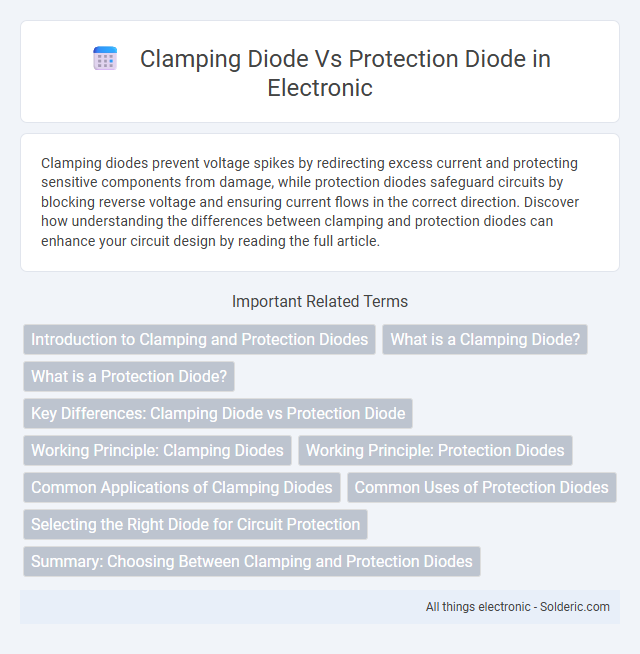Clamping diodes prevent voltage spikes by redirecting excess current and protecting sensitive components from damage, while protection diodes safeguard circuits by blocking reverse voltage and ensuring current flows in the correct direction. Discover how understanding the differences between clamping and protection diodes can enhance your circuit design by reading the full article.
Comparison Table
| Feature | Clamping Diode | Protection Diode |
|---|---|---|
| Purpose | Limits voltage spikes to a specific clamp level | Prevents damage from reverse polarity or voltage surges |
| Working Principle | Redirects excess voltage to ground or supply line | Blocks or shunts unwanted current to protect circuits |
| Common Uses | Protecting sensitive components from transient voltage | Reverse polarity protection, surge suppression |
| Placement | Across the component terminals (parallel) | In series or parallel depending on protection type |
| Voltage Clamping Level | Fixed by diode forward voltage and clamp circuit | Dependent on diode breakdown or forward voltage |
| Example Devices | Zener diode clamps, TVS diodes | Schottky diodes, flyback diodes |
Introduction to Clamping and Protection Diodes
Clamping diodes are primarily used to limit voltage spikes by redirecting excess voltage away from sensitive components, thereby preventing damage during transient events. Protection diodes function by safeguarding circuits from electrical faults such as reverse polarity or overvoltage conditions, ensuring reliable operation and preventing component failure. Both diodes are critical in electronic design for enhancing durability and maintaining circuit integrity under stress.
What is a Clamping Diode?
A clamping diode is designed to limit voltage by redirecting excess current when voltage exceeds a predefined threshold, protecting sensitive electronic components from voltage spikes. Unlike general protection diodes, clamping diodes are specifically placed to clamp voltage levels and prevent transient overvoltage conditions. Commonly used in circuits with inductive loads like motors or relays, clamping diodes ensure reliable operation by absorbing voltage surges.
What is a Protection Diode?
A protection diode safeguards electronic circuits by preventing voltage spikes or reverse polarity that can damage components. It is typically connected in parallel with sensitive elements to redirect excess current safely away. Your circuit's reliability improves significantly by incorporating a protection diode to block harmful voltage transients.
Key Differences: Clamping Diode vs Protection Diode
Clamping diodes limit voltage spikes by diverting excess voltage to ground or to a power supply rail, protecting sensitive components from transient overvoltages. Protection diodes serve a broader role, including reverse polarity protection and current blocking to safeguard circuits in various fault conditions. Understanding the specific function of your circuit will help determine whether a clamping diode or a general protection diode is the optimal choice.
Working Principle: Clamping Diodes
Clamping diodes operate by limiting voltage spikes by redirecting excess voltage to a reference point, typically ground, protecting sensitive electronic components from transient overvoltages. When the input voltage exceeds a predefined threshold, the clamping diode becomes forward-biased, conducting current and maintaining the voltage at a safe level. This precise voltage regulation prevents damage in circuits subjected to inductive loads or electrostatic discharge events.
Working Principle: Protection Diodes
Protection diodes operate by providing a pathway for voltage spikes to safely dissipate, preventing damage to electronic components. These diodes are typically connected in reverse bias across sensitive circuits, clamping excessive voltage by conducting when the voltage exceeds a certain threshold. Their fast response time and low leakage current ensure effective transient voltage suppression in various applications, such as power supplies and signal lines.
Common Applications of Clamping Diodes
Clamping diodes are commonly used in voltage regulation circuits to prevent voltage spikes from damaging sensitive components, especially in switching power supplies and relay driver circuits. They are essential in protecting transistors and integrated circuits by limiting the voltage to a safe, predetermined level. Applications also include transient voltage suppression in automotive electronics and signal line protection in communication devices.
Common Uses of Protection Diodes
Protection diodes are commonly used to safeguard sensitive electronic components from voltage spikes and reverse polarity conditions in circuits such as power supplies, automotive electronics, and relay coils. Clamping diodes, a type of protection diode, specifically limit voltage to a safe level by redirecting excess current, preventing damage during transient events. Your devices benefit from improved reliability and longevity by integrating protection diodes in applications exposed to inductive loads or switching noise.
Selecting the Right Diode for Circuit Protection
Selecting the right diode for circuit protection involves understanding the distinctions between clamping and protection diodes. Clamping diodes are designed to limit voltage spikes by redirecting transient currents, commonly used in inductive load circuits, while protection diodes, such as TVS or Zener diodes, offer broader safeguarding against overvoltage and electrostatic discharge events. Evaluating the operating voltage, response time, and energy absorption capacity ensures optimal diode selection tailored to specific circuit protection requirements.
Summary: Choosing Between Clamping and Protection Diodes
Clamping diodes are designed to limit voltage to a safe level by redirecting excess current, protecting circuits from voltage spikes. Protection diodes serve as a broader safeguard against various electrical hazards, including reverse polarity and transient voltages. Your optimal choice depends on whether your primary concern is voltage spike control or comprehensive circuit protection.
Clamping diode vs protection diode Infographic

 solderic.com
solderic.com